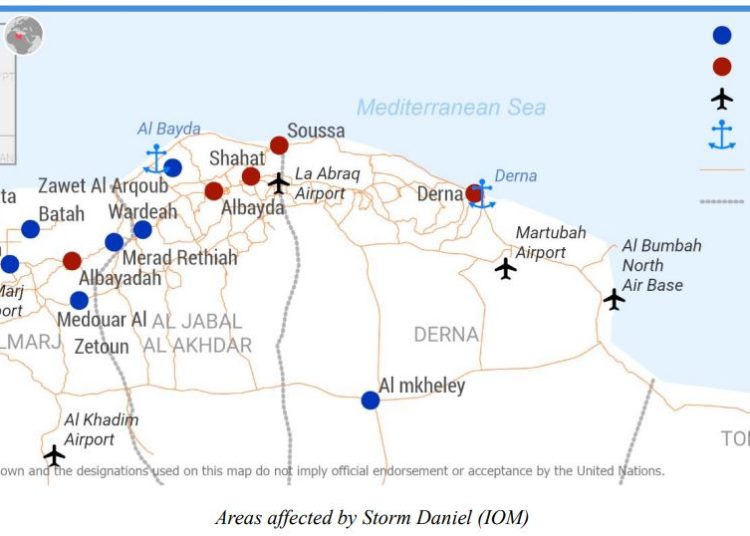Ten days have passed since Storm Daniel battered the northeastern coastal areas of Libya (10 September), the UN Office for the Coordination of Humanitarian Affairs (OCHA) reported yesterday in its routine brief. It said the catastrophic consequences for the affected people and infrastructure are unprecedented.
It still confirms that the World Health Organization (WHO) has officially only confirmed 3,958 fatalities as of 16 September. Among these, were 406 migrants, including 250 Egyptian and 150 Sudanese nationals and an additional 6 Bangladeshi nationals were reported missing according to the International Organization for Migration (IOM).
It is unclear when the Libyan authorities will come up with a more realistic number of ‘‘missing presumed dead’’.
Water contamination
The report says there have been 150 reported cases of illness due to water contamination and Derna has recorded at least 55 children who have become sick because of contaminated water.
Waterborne diseases
Concerns about a potential health crisis are growing as a significant number of dead bodies remain under the rubble. With the severe damage to water sources and sewer networks, concerns are mounting about the spread of waterborne diseases.
Nine UN agencies still on the ground
It states that teams from nine UN agencies have been on the ground delivering life-saving assistance in the most affected areas despite access challenges.
More aid pledged
The report also says that more pledges and in-kind assistance have been announced including from Canada, France, the United States,
Turkey and ECHO.
Search and Rescue continuing
On the conflicting news of some states and Libyan agencies pulling out from Derna, the UN brief says despite the slim chances of finding survivors, the search-and-rescue operations are ongoing along with the recovery of dead bodies. There are several reported casualties among humanitarians.
40,000 displaced
It reports that according to the IOM, 40,000 people have been displaced in the northeast of Libya, including 30,000 in Derna. Schools have been repurposed as temporary shelters for internally displaced persons (IDPs) in the affected areas.
Food shortages
Destroyed bridges and blocked roads have severely disrupted local food supply chains, hampering access to markets and causing food shortages. Lack of updated reliable data on the impact of the floods due to access challenges is delaying much-needed relief efforts, according to the World Food Programme (WFP).
Medical needs
Additionally, as Libya is entering its rainy season with the risk of disease outbreaks heightened, according to International Medical Corps (IMC). Due to the substantial impact on healthcare infrastructure, there is an urgent need for immediate emergency medical assistance and body bags for burials.
In Derna, there are four functional primary healthcare centres and one working hospital, where medical supplies, equipment and medication, as well as medical personnel, are needed.
Mental health support needed
Due to the distress and grief of victims of the flood, mental health and psychosocial support (MPHSS) is required to help survivors cope with the profound emotional trauma. Recognizing the significant psychological impact of this disaster, particularly on children, and providing psychosocial support remains a top priority in the response efforts.
EU Copernicus satellite images of Flood Daniel hit Libya released (libyaherald.com)
Conflicting news over ending of Search and Rescue for survivors in Derna (libyaherald.com)
UNSG Guterres calls for opening of investigations into collapse of Derna dams (libyaherald.com)
Derna update: International aid continues to arrive, infrastructure damage update (libyaherald.com)
Latest UN satellite imagery shows extent of Storm Daniel destruction in Derna (libyaherald.com)
More than 5,300 dead and 10,000 missing in Derna disaster (libyaherald.com)
More than 2,000 dead and thousands missing after Storm Daniel hit eastern Libya (libyaherald.com)
Libya hit by storm Daniel with eastern region suffering worse damage (libyaherald.com)








